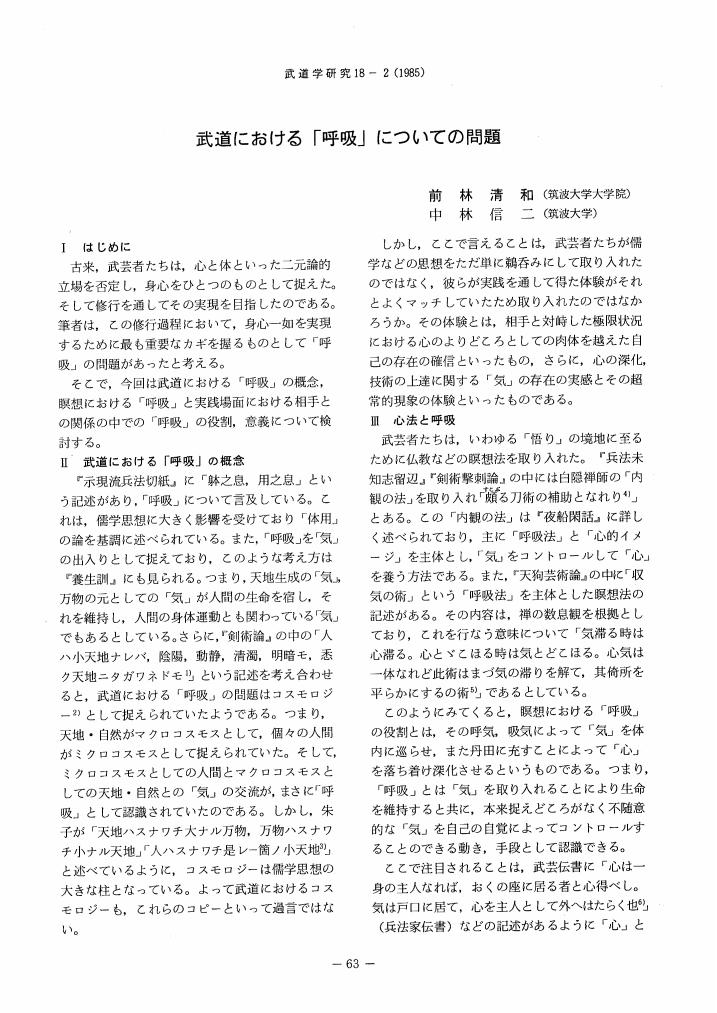2 0 0 0 OA 武芸における「瞑想」についての一考察 ―心身論的視点からの序説として―
- 著者
- 前林 清和 中林 信二
- 出版者
- 日本武道学会
- 雑誌
- 武道学研究 (ISSN:02879700)
- 巻号頁・発行日
- vol.18, no.3, pp.6-15, 1986-02-28 (Released:2012-11-27)
- 参考文献数
- 46
From ancient times, Meiso (meditation) has shaped the core of the ascetic exercises, “Syugyo” in case of orientalism. Meiso (meditation) has also been introduced into the process of “Syugyo” by Japanese military arts. So, this study intended to classify the concept of Meiso (meditation) and to investigate what Meiso (meditation) in the military arts had been.Summaries are as follows;(1) Meiso (meditation) is the method to experience a state of unconsciousness above consciousness, and to unify both.(2) According to the psychological point of view, Meiso (meditation) has two aspects; the one is accompanied with active image (for example Yoga) the other is not (Za-Zen). The former refuses external stimuli, the latter is openminded and then keeps awaking situation.(3) From the physical viewpoint has static manner (Za-Zen) and active ones (Kinhin, Jogyozanmai).(4) Statical meditation in the military arts has been used in order to extinguish worldly thoughts and get to the higher state of mind.(5) Performing the practice the military arts, Keiko (Kata) itself can be explained as active meditation with physical exercise, that has made much of the respiratory method. That state of mind is similar to that of Zen.
2 0 0 0 OA 近世武芸における「呼吸」と「気」の諸問題
- 著者
- 前林 清和
- 出版者
- 日本武道学会
- 雑誌
- 武道学研究 (ISSN:02879700)
- 巻号頁・発行日
- vol.20, no.1, pp.51-61, 1987-07-31 (Released:2012-11-27)
- 参考文献数
- 54
In recent years, they are calling the contradiction of the Cartesian mind-body dualism in question in the West. And scholars in various circles are re-examining heartily the mind-body problem in order to find a way out of the mental and social unrest. They are taking special notice of the traditional patterns of thinking in the East, because there is a strong tendency in the Eastern theories of the body to grasp the mind and body as an inseparable unity. So, this study intended to relate “ki” with “breath”, considered to be central issue in the Eastern theories about the body, in the military arts of Japan. Summaries are as follows; 1. “BREATH” was thought of coming and going of “ki” in the military arts. And the relationship between the cosmos and the human beings has been discussed as the correspondence between the macro-cosmos and the micro-cosmos (cosmology). This tought originated in China (Confucianism).2. “Breath” in the military arts has been used in order to control “ki”, to get to a higher state of mind and to improve ability of the body. x 3. In the match, “breath” was one of the ways of making “ma” (timing, rhythm, pace) between the player and his opponent. And in the case of a higher rank, an expert could control his opponent by using only “ki”.
1 0 0 0 OA 武道における「呼吸」についての問題
1 0 0 0 OA わが国の学校における防災教育の現状と課題 -全国規模アンケート調査の結果をもとに-
- 著者
- 柴田 真裕 田中 綾子 舩木 伸江 前林 清和
- 出版者
- 防災教育学会
- 雑誌
- 防災教育学研究 (ISSN:24359556)
- 巻号頁・発行日
- vol.1, no.1, pp.19-30, 2020 (Released:2021-10-19)
日本の小学校,中学校,高等学校の防災教育の実情と課題についてアンケート調査によって明らかにした。 結果は次のとおりである。 1)防災教育を実施していない学校が非常に多く,その割合は,小学校が約20%,中学 校が約30%,高等学校が約40%であった。 2)ほとんどの学校で,防災教育の年間実施回数は,1 回から3 回程度であり,体系的な 教育がなされていない。 3)文科省が求めているような各教科による防災教育はほとんど行われていない。 4)教員の防災に関する知識が不足している。 5)防災教育教材の多くが受け身型の授業のための教材であり,教員が使用したくなるア クティブラーニング教材が少ない。
1 0 0 0 OA 災害と祭についての研究―心性・魂・身体性―
- 著者
- 前林 清和
- 出版者
- 身体運動文化学会
- 雑誌
- 身体運動文化研究 (ISSN:13404393)
- 巻号頁・発行日
- vol.27, no.1, pp.17-27, 2022-03-15 (Released:2022-04-12)
- 参考文献数
- 40
In this study, we focus on God and human beings during life and death in the event of a disaster, and consider their mentality, soul, and physicality.The disaster area is a space-time where both life and death exist.In other words, it is a chaotic space-time where the raging gods, the spirits of the dead, and the souls of the victims who are likely to float are chaotic. The festival is a device that calms, inspires, and restores this space. At the festival, God possesses and dancers who perform requiescats. In a state of unity between God and man, it calms the raging god (earth spirit), mourns the souls of the dead, calms the souls of the victims, and inspires them. In other words, the rituals of the multi-layered soul will revitalize the affected areas and the people of the victims.That is why, after a disaster, the revival of the festival is desired above all in the disaster area.
1 0 0 0 OA カンボジアにおける地雷回避教育プログラムの研究開発
1 0 0 0 近世柔術伝書にみられる心身観
- 著者
- 前林 清和
- 出版者
- 人体科学会
- 雑誌
- 人体科学 (ISSN:09182489)
- 巻号頁・発行日
- vol.1, no.1, pp.89-99, 1992-04-30
In general, people think that a view of the mind-body in the East is monism, but a specialist in Bugei and Geido of Japan thought realistic, fine mind-body theory. It is a theory formulated in light of the practice, not the Cartesian mind-body dualism, not the general mind-body monism in the East. The purposes of this study are to clarify this idea by a analysis of Jujutsu's historical materials in the Edo era. Our study can be summarized as follows; 1) The view of Jujutsu's mind-body founded on Confucianism's cosmology, so that it regarded nature as macro-cosmos, a man as micro-cosmos. This viewpoint was the basis of various levels in Jujutsu. 2) The characteristic of the technical theory in Jujutsu was expressed by the proverb "Ju yoku go wo seisu". This proverb means that a soft action controls a hard action, or a soft idea controls a hard action. In Jujutsu, it was used to express a ideal of mental state and quality of strength on a practice or on a battle. 3) The trainning theories of Jujutsu attach importance to a waist and "Seika Tanden" (a belly under a navel). "Seika Tanden" was grasped the tank of "Qi" in the East.
